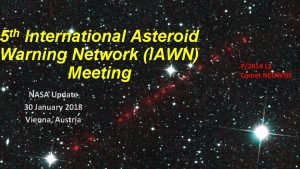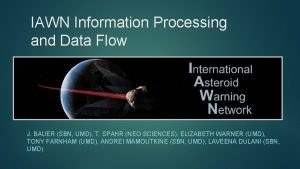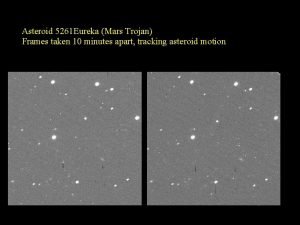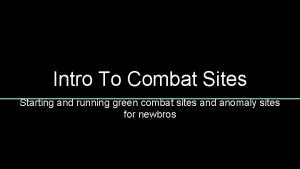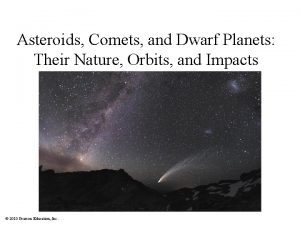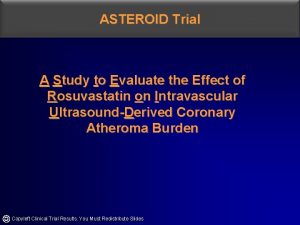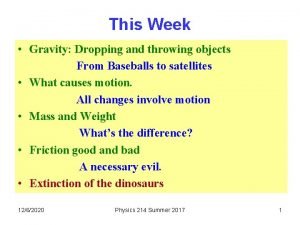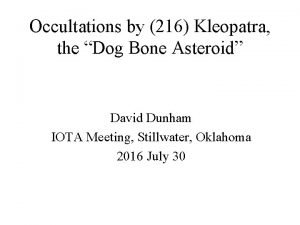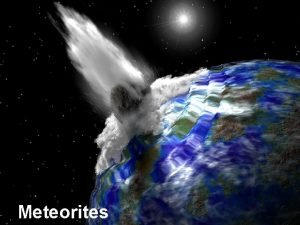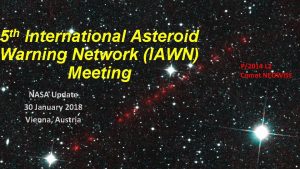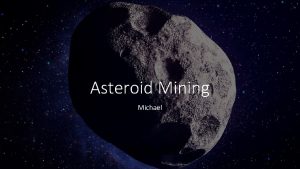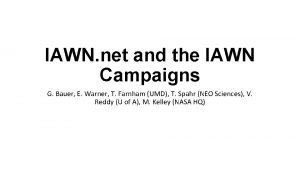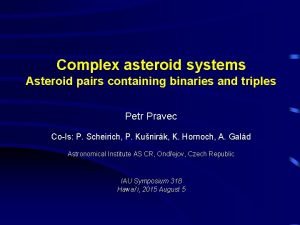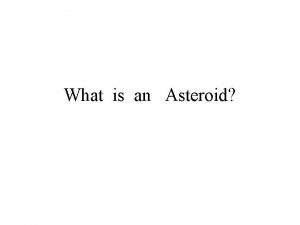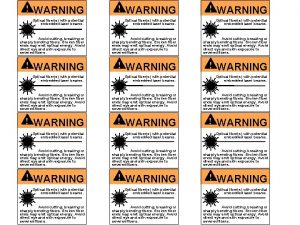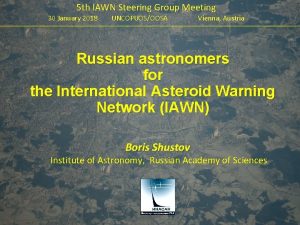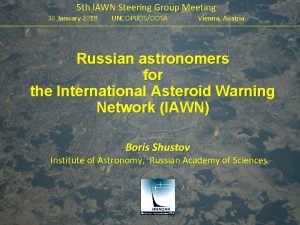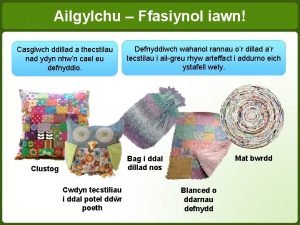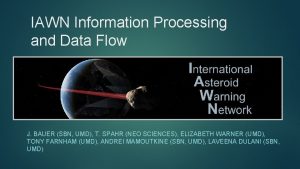th 5 International Asteroid Warning Network IAWN Meeting
















- Slides: 16

th 5 International Asteroid Warning Network (IAWN) Meeting NASA Update 30 January 2018 Vienna, Austria P/2014 L 2 Comet NEOWISE

NASA’s NEO Search Program: Surveys Current Surveys: • • • NEOWISE CSS Pan-STARRS ATLAS LINEAR/SST (being re-assembled in Western Australia) LINEAR/SST 3. 5 -m (to Australia) Catalina Sky Survey 1. 5 -m 0. 7 -m NEOWISE 0. 4 m Pan-STARRS Two 1. 8 -m telescopes Haleakalā, Maui JPL Sun-synch LEO ATLAS 0. 5 -m Haleakalā Mauna Loa

NEAs Discovered (to date) NEA total: 17, 587 PHA: 1, 887 (187 > 1 km) NEC: 106 https: //cneos. jpl. nasa. gov/stats Alan Chamberlin JPL/Caltech

NEAs Discovered by Survey (to date) 2053 discoveries in 2017

NEAs Discovered by Survey (140 m+) 538 discoveries in 2017

NEO Population – 140 meters and larger* *based on an estimated population of ~25, 000

Recovery of 2012 TC 4 Goal - Exercise the Planetary Defense system • Recovery and Follow-up: Recovery confirmed early August 2017 • Characterization: Light curves, photometry, spectroscopy, radar • Modeling: orbit determination, threat assessment and impact modeling exercises • Communications: • NASA management, White House, other agencies • Within the NEO community and with the public • International Asteroid Warning Network (IAWN) participation

Recovery of 2012 TC 4 (Initial Results) • Astronomers from the U. S. , Canada, Colombia, Germany, Israel, Italy, Japan, the Netherlands, Russia and South Africa tracked TC 4 • Close approach occurred at about 43, 700 km • Radar observations of 2012 TC 4 seem to indicate an oblong shape of about 6 x 12 meters in size • Light curve and then radar showed it tumbling with about a 12 minute period • Precision orbit determination was able to rule out any impact by TC 4 for the foreseeable future • More information: http: //2012 tc 4. astro. umd. edu/

prior to 2012 Earth encounter post-2012 flyby post-2017 flyby

Science Nuggets • Discovered by Bobby Bus in 1981 (1981 ET 3) • ranks 4 th in size of large PHOs • Came within 0. 047 AU of Earth on 1 Sept 2017 • 3 rd NEO found to be a ternary system

Discovery of First Interstellar Object • 1 I/2017 U 1 (‘Oumuamua) • Discovered on 19 October 2017, by the Pan-STARRS 1 telescope during near-Earth object survey operations • Speed and trajectory indicate it originated outside of and is not bound to our solar system • Object is asteroidal in nature (no coma observed) (real image) • Object is highly elongated, with an axis ratio >3: 1 perhaps 10: 1 • Observations (artist’s concept) suggest a surface reddened due to irradiation by cosmic rays over its history


Sentry object of interest - 2017 YZ 1 • Discovered by the Catalina Sky Survey (G 96, Mt. Lemmon) on 20 December 2017 • 43 observations over two weeks • Diameter 250 meters • Impact probability < 1/20, 000 on 20 June 2047 • 1 (Green) on the Torino scale due to size, and was re-assigned to 0 with further observations on 18 January 2018.

PDCO Flight Mission Projects NEOWISE • Continues in extended NEO survey operations NEOCam: Near-Earth Object Camera • Infrared survey telescope optimized for meeting congressional mandate to find and characterize NEOs down to 140 meters in size • Continues in extended Phase A • • DART: Double Asteroid Redirection Test Demonstration of kinetic impactor technique Target - Moon of 65803 Didymos Launch 2020, impact 2022 Continues in Phase B

NEO Survey Science Definition Team Report* Findings Finding 1. Future goals related to searching for potential Earth‐impacting objects are best stated explicitly in terms of the statistical risk characterized and should be firmly based on cost/benefit analyses. Such a search would best be executed in a way that eliminates the maximum amount of statistical risk uncertainty per dollar of investment. Finding 2. It would be most productive to develop and operate a NEO search program with the goal of discovering and cataloging the potentially hazardous population sufficiently well to eliminate 90% of the uncharacterized risk from sub‐kilometer objects (i. e. , sub‐global impact effects). Over a period of 9 to 25 years, a number of system approaches are capable of meeting this search metric with quite good cost/benefit ratios. Finding 3. The satisfaction of the 140‐meter cataloging objective will require space‐based search system(s). Infrared (IR) and visible sensors in the 0. 5‐ to 1. 0‐meter aperture range are credible and cost/benefit‐favorable options that use available technology. *https: //www. nasa. gov/sites/default/files/atoms/files/2017_neo_sdt_final_e-version. pdf

Observations Worldwide (as tallied by the MPC) 22 million observations world wide (of which 201, 000 of NEOs) 47 countries + 1 observatory in space
 International asteroid warning network
International asteroid warning network Lindysyn llwglyd iawn
Lindysyn llwglyd iawn Iawn website
Iawn website 5261 eureka
5261 eureka Serpentis yard
Serpentis yard Scintillate scintillate asteroid minific
Scintillate scintillate asteroid minific Where can we mostly asteroid found
Where can we mostly asteroid found Asteroid belt origin
Asteroid belt origin Asteroid trial
Asteroid trial Asteroid belt
Asteroid belt Asteroid impact simulation
Asteroid impact simulation Dog bone asteroid
Dog bone asteroid Meteorite identification pictures
Meteorite identification pictures For todays meeting
For todays meeting Meeting objective
Meeting objective What is meeting and types of meeting
What is meeting and types of meeting What is meeting and types of meeting
What is meeting and types of meeting
